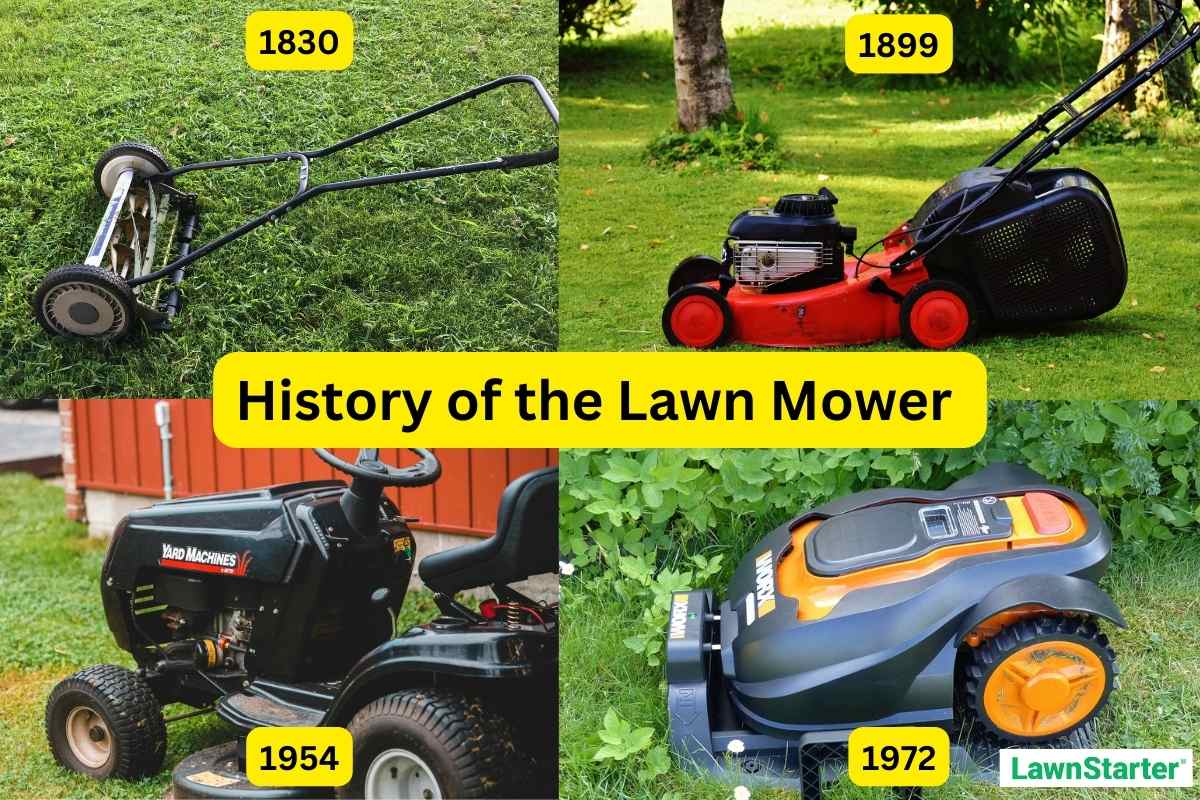
Welcome to our DIY lawn mower maintenance guide, where we’ll share step-by-step tips on seasonal maintenance. With a little know-how and some elbow grease, it’s possible to keep your mower working smoothly from spring through fall.
Whether you’re a seasoned DIYer or new to the maintenance world, this guide will lead you through the basics and share expert advice to keep your lawn mower in top form from the first spring dandelions to the last fall leaves. So, let’s learn how to change the spark plug, replace the air filter, winterize, and more.
Pre-Maintenance Preparation
Lawn mowers are essential lawn care equipment for homeowners, and caring for them begins with a prepared workspace. Here’s a checklist to ensure you’re ready:
- Clear workspace: Set up a clutter-free, well-lit environment to work comfortably around your mower.
- Consult the owner’s manual: Review manufacturer guidelines for maintenance methods and schedules by pulling out the manual. It helps you familiarize yourself with your lawn mower’s specifications and recommendations.
- Collect tools and materials: Gather all of the necessary tools and supplies, including:
- Heavy-duty work gloves
- Safety glasses or goggles
- Wrench
- Small engine oil
- New spark plug
- New air filter
- Clean cloth and mild soap for cleaning
- Cool down the machine: Allow your mower to cool down before beginning maintenance to avoid burns and allow for an accurate inspection of all its parts.
- Disconnect power source: To avoid accidental starts while you’re working on your mower, disconnect it from its power source before you get to work. For gas mowers, that means disconnecting the spark plug wire. For electric mowers, unplug the mower or remove the battery.
Remember: Lawn mowers, especially gas lawn mowers, are powerful machines that can be dangerous if misused. So put on your safety glasses and gloves, and ensure you’re working in a well-ventilated place to avoid breathing in fumes. Also, never work on a mower that is still hot or running.
Essential Seasonal Mower Maintenance
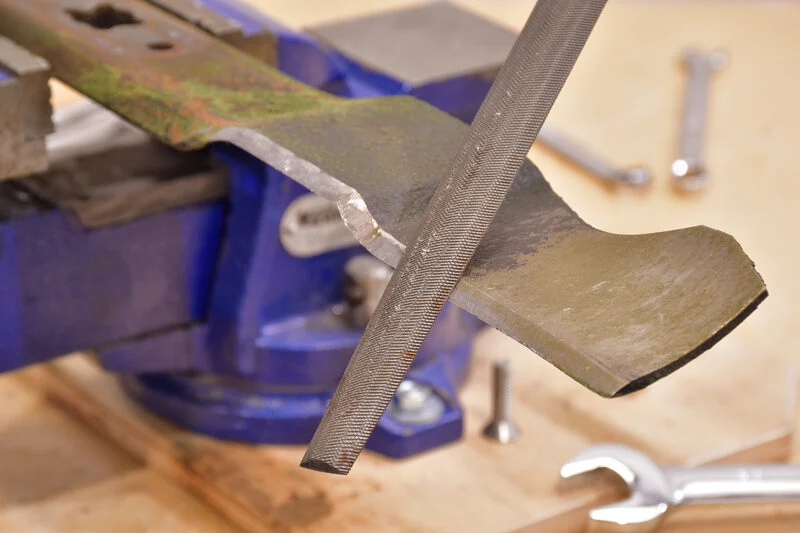
Your lawn mower maintenance schedule is heavily influenced by the seasons. Follow our list of essential seasonal mower care to ensure your mower is running smoothly during spring, summer, and fall.
Note: Since gas and electric mowers are the most common types of residential mowers, we’ll focus on those in this section. However, lubricating, sharpening and aligning blades, and cleaning the mower (with a dry brush) are also essential tasks for reel mowers.
Spring Preparation
The best time to start maintenance for the busy spring season is actually before spring arrives. When you notice the weather changing and warming up again, you can begin preparing your lawn mower for spring:
1. Clean or replace the air filter: Give it a soft tap and use mild soap and water to wash the filter gently. If it’s clogged or damaged, replace it with a new one. Learn how to tell when your mower’s air filter needs a full replacement vs. a cleaning in our guide, How to Clean and Change a Lawn Mower Air Filter.
According to Marcus Garner, Urban Regional Extension Agent for Alabama A&M & Auburn Universities Extension, “Surprisingly, most people forget to clean the air filter.” But as he explains, a dirty air filter “impacts the engine, hindering its efficiency, reducing power, and increasing fuel consumption.”
If your mower has a fuel filter, this is a good time to change it as well. Check the manufacturer’s guide for precise instructions on how to replace the filter.
2. Change the spark plug: If you have a gas mower, your spark plug needs to be changed every 25-50 hours of operation or once a season. Examine your spark plug by removing it with a socket wrench after disconnecting the spark plug wire. If it is covered with carbon deposits or is worn out, it is time to replace it. However, you may be able to get away with cleaning it and putting it back.
Visit our guide on How to Change Spark Plugs on a Lawn Mower for step-by-step instructions.
3. Change oil: As with spark plugs, this step applies only to gas mowers. Fresh engine oil prevents moisture buildup and “protects the internal moving parts” of your mower, according to Garner. Change the oil at least every 25 hours of use or once a season.
- Locate the oil drain plug under the mower.
- Place an oil pan beneath and remove the plug.
- Drain the old oil completely.
- Replace the plug, then add the recommended type and amount of oil as per the manufacturer’s manual. Don’t forget to dispose of the old oil properly.
Check out our complete guide, How to Change the Oil in a Lawn Mower, for a more in-depth look at this essential task.
4. Refuel: Spring is a good time to refuel your tank. Remember to use the right fuel for your lawn mower (read the manufacturer’s instructions to find this information). Make sure both the fuel and the machine are cool before refueling the tank.
- Open the cap carefully to gradually release the pressure.
- Fill the tank with the help of a funnel to avoid spilling.
- Clean the area around the cap with a damp cloth.
- Close the cap tightly.
- Store the fuel away in a dry and protected area.
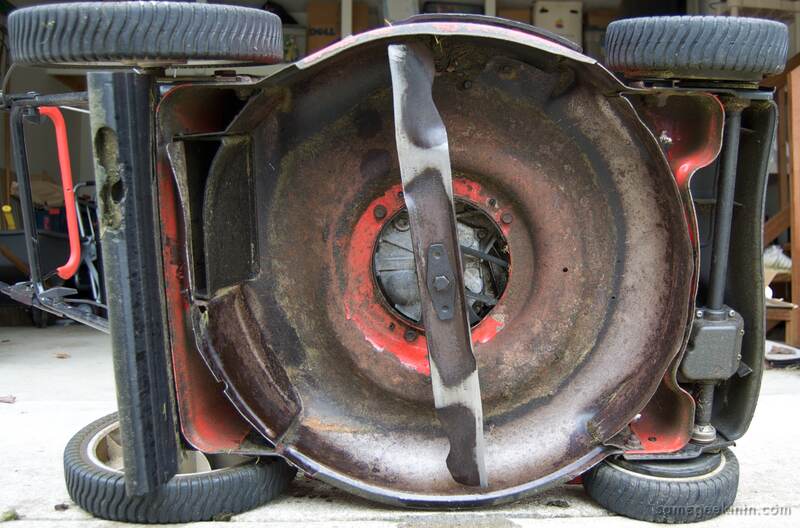
5. Sharpen mower blades: Dull blades use extra fuel and damage the grass blades instead of cutting them, exposing your lawn to disease and stress. J. Bryan Unruh, Associate Center Director and Professor at the West Florida Research and Education Center, says, “For an average size residential lawn, it would be ideal to sharpen the blade every 4 to 6 mowings.”
He also explains that the ideal frequency depends on your soil type: “In areas with sandy soils or significant bare areas, the blade(s) dull much more quickly, needing to be sharpened more frequently.”
Remember also to balance the blades since unbalanced blades cause stress on the mower’s engine and result in uneven cuts. To balance and sharpen the mower blades:
- Remove the blades using a wrench.
- Place the blade in a vise, and file the edges down to the original angle.
- Use a blade balancer to maintain proper weight distribution.
- Reattach the blades carefully to avoid injuries.
For Unruh, sharpening blades and maintaining the mower’s safety features (such as belt covers and the side discharge chute) are the two most important maintenance tasks for home lawn mowers.
He explains, “Dull blades produce a ragged cut edge, making it more susceptible to insect and disease incidence and causing the turf to use more water.” If you’re short on time, Unruh recommends “purchasing a spare mower blade” to avoid adding another task to your list of Saturday chores.
6. Check batteries: While battery-powered lawn mowers take a lot less maintenance than gas mowers, it’s still a good idea to check your batteries once a month. A well-maintained lawn mower battery usually lasts three to five years and guarantees that your mower starts consistently and reliably.
- Examine the battery terminals for signs of rust or corrosion. If you find any, carefully clean off the rust with a wire brush and a mixture of baking soda and water. This prevents poor electrical connections.
- For mowers with traditional lead-acid batteries, ensure the water levels in each cell are appropriate. If they’re low, use distilled water to raise them back to normal.
- Charge the batteries after removing them from the mower. Let them cool down in a well-ventilated area before charging. Use a battery charger compatible with your battery type and connect it according to the manufacturer’s instructions.
Note: Check our guide on Gas vs. Electric Lawn Mowers to understand the difference between the two machines.
See Related: How to Charge, Maintain Lawn Mower Batteries
7. Check or replace belts: Check your lawn mower belt for cracks, burns, or damage. If you see any of these signs, it is time to change the belt.
If you have a riding mower with a removable deck:
- Raise the mower’s deck if yours is removable.
- Rotate the idler pulley using a socket wrench to release the belt.
- Replace the old belt with the new one, and turn the idler pulley back into place.
- Turn on the engine to test the new belt, with the deck still raised. Remember also to engage the blades. Be attentive to unusual noises that might indicate something’s not working right.
- Reassemble the deck and test the mower on your lawn for a final check.
If you have a push mower:
- Make sure the fuel tank isn’t full and tighten the fuel tank cap.
- Remove the spark plug for safety.
- Turn your mower on its side.
- Loosen the bolts on the underside of the mower using a socket wrench. Do the same process with the bolts that secure the shroud on the top of the mower, which secures the other end of the belt.
- Remove the old belt and install the new one.
- Reattach the bolts and rotate the blade slowly to check if the belt is properly lined up.
8. Check tires: After seasons of use, your tires might start to show signs of damage:
- Deep cracks that might make your tires lose air.
- Worn out tread. This can lead to loss of traction, making the tire slippery and less effective on slopes.
- Pressure loss. Measure the tire’s pressure using a pressure gauge to ensure it is within the manufacturer’s recommended range.
Taking care of your spring mower maintenance takes time, but for Garner, these chores are an important and worthwhile investment: “In my opinion, the most crucial tasks involve keeping the engine in tune with the number of running hours it’s providing and delivering routine maintenance to preserve the engine.”
He continues, “Providing essential items like fresh gasoline for combustion, premium oil for lubrication, clean oil, air, and fuel filters, and sharp blades for cutting” are simple but key tasks that help extend the life of your mower.
Summer Maintenance
1. Clean the mower deck: You should clean the mower deck after every mow or at least twice each mowing season to prevent the buildup that gets trapped underneath the mower from hindering airflow and causing rust.
- Remove the spark plug to disconnect the engine from power.
- Carefully turn the mower on its side, ensuring the air filter and carburetor face up to keep oil and fuel from pouring into it.
- Use a sturdy brush, scraper, blower, or a specialist mower cleaning tool to remove the built-up debris gently.
For more detailed advice, refer to our complete step-by-step cleaning guide: Best Way to Clean a Lawn Mower Deck.
2. Monitor oil level: Keep an eye on the oil levels to ensure your mower keeps functioning smoothly during the season. Locate the oil cap and loosen it. In most cases, there will be a stem attached to the cap indicating the ideal oil level. Add more oil to your mower if necessary.
4. Check tire pressure: Low tire pressure can lead to uneven cutting heights, scalping, and a less polished look for your lawn. Use a tire pressure gauge to check the tire pressure and compare it to the manufacturer’s suggestions in your mower’s manual. Inflate the tires to the proper level if the pressure is too low. If it’s too high, release air from the tires until it’s right.
5. Lubricate the moving parts: Pivot points, wheel axles, and other joints or moving parts on your lawn mower require sufficient lubrication to lower friction and run smoothly.
- Consult your mower’s owner’s manual to locate the parts that require oil.
- Choose the proper lubricant for each component — typically a multi-purpose oil or grease, as the manual specifies.
- Pay close attention to the mower’s blade spindle and drive system components.
- Apply a generous amount of lubricant to each part.
- Move the components back and forth a few times to ensure the lubricant is uniformly distributed.
Pro Tip: Remember to check your owner’s manual before performing any maintenance task. For Garner, not reading your manual, “which provides straightforward maintenance instructions for caring for the engine based on the factory recommendations,” is one of the common mistakes homeowners make when caring for their mowers.
Fall Winterization
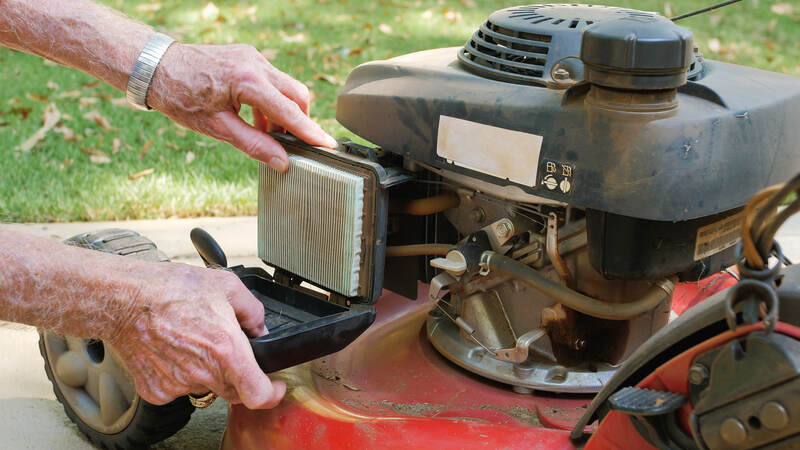
1. Clean the mower thoroughly: This eliminates grass, dirt, and debris before storing the mower for winter. Cleaning the mower’s surfaces prevents corrosion and allows for a fresh start in spring.
Remove the blades to clean the undercarriage. Then, using a putty knife, scrape stuck grass from the mower and the blades. You can also use a pressure washer to clean the blades and the undercarriage.
2. Drain the gas: Unruh notes that draining the gas from the engine is an important step in winterizing a gas lawn mower: “For gas mowers, draining fuel in the wintertime is important. Cleaning the air filter is also a must.” To prevent carburetor degradation, run the mower until the gasoline tank is empty.
Generally, you should drain the gas after 30 days of not operating the mower. According to Garner, “Allowing ethanol or untreated fuel to remain in the tank for months can cause issues when starting the lawn mower.” Follow our detailed guide on How to Drain Gas From a Lawn Mower to complete the process correctly and safely — with or without a siphon.
Pro Tip: If you prefer to leave gas in the mower over winter, use a fuel stabilizer instead, which can prolong the life of the fuel and prevent it from deteriorating. Always check the stabilizer label to know how long the product can preserve the fuel. Similarly, check your mower’s manual for specific storage recommendations.
4. Remove battery: If you have an electric mower, remove the batteries and store them away from sunlight at half-charge or slightly less. Unruh explains, “For electric or battery-powered equipment, strictly follow the manufacturer’s recommendations for battery cycling/charging.”
5. Store in a cool, dry place: Finally, disconnect the spark plug wire, and use a cover or tarp to protect your mower from dust and moisture. Store your mower in a dry, covered spot — your garage or shed will do nicely. Place a wooden block under the mower to prevent tire damage when storing it on a concrete floor.
As Garner says, “Storing equipment away from the elements or climate to reduce exposure to extreme heat and cold” is another essential step in caring for your lawn mower.
Preventative Maintenance
“Preventive routine maintenance goes a long way to keeping a mower operating,” Unruh says. He also explains that most manuals come with a recommended maintenance schedule. But if you’ve lost your user manual, check out our frequency table as a general guide on how often to perform key preventive lawn mower maintenance tasks:
| Annual Tasks | Monthly Tasks | Weekly Tasks |
| Clean or replace the air filter | Check batteries | Clean mower deck |
| Change the spark plug | Refuel tank | |
| Change the oil | Lubricate moving parts | |
| Sharpen blades (2x per season) | Check tires | |
| Check the belt and replace if necessary | Monitor oil level | |
| Drain the gas or add fuel stabilizer (winterization) | Check mower blades for sharpness and balance | |
| Remove batteries (winterization) |
When To Call a Professional
Depending on how often you use your lawn mower, the frequency of these tasks might increase. Having an annual service by a professional is also a good idea if you’re unsure how to do the job yourself. As Unruh says, “Having a professional check the equipment becomes more important for those that are less mechanically inclined.”
Garner also advocates for having your mower serviced routinely, even before it shows a problem: “Routine service by a professional is necessary to adjust the intake and exhaust valves, carburetor, sensors, and other parts of the mower.” After all, he says, “Humans sometimes need a doctor, and a mower sometimes needs a mechanic.”
Professional lawn mower repair costs range from $75 to $550, depending on what needs replacing and your mower type. For walk-behind mowers, expect to pay around $125 for a repair, while riding mower repairs cost around $175.
Pro Tip: Make your spring tune-up appointment while it’s still too cold to mow. As Unruh notes, “Spring tune-ups are key, but schedule it early due to the busy schedules most professionals have each spring.”
Troubleshooting Common Issues
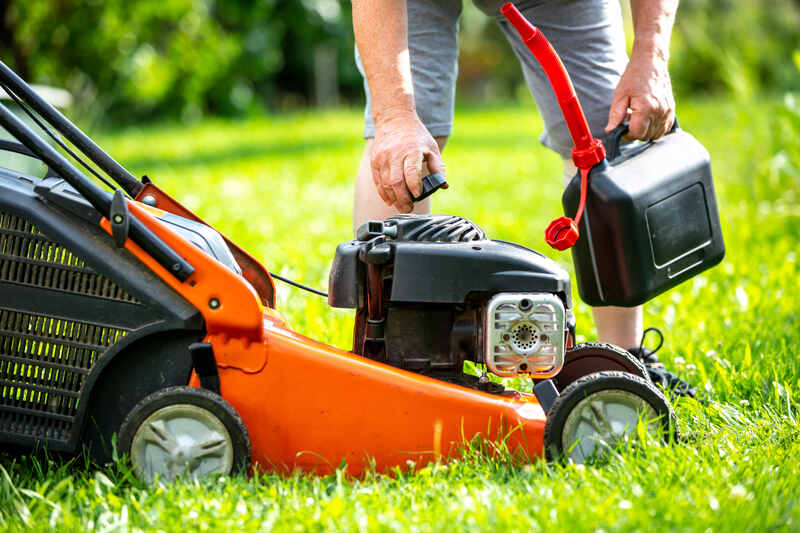
1. Lawn mower won’t start: This can happen due to old gas, a clogged carburetor, a dirty spark plug, or a dirty air or fuel filter. Before doing anything, remember to disconnect the spark plug to ensure your safety:
- Try draining last season’s gas and adding fresh fuel to the tank.
- Check the spark plug. If necessary, give it a nice clean and reconnect it.
- Clean the air filter or replace it if necessary.
- Give the carburetor a tap to try and get the gas moving. If this doesn’t work, try replacing the fuel filter.
2. Pull cord is stuck: If your cord feels hard to pull or completely stuck, know that this can happen due to grass clippings clogging the blades or your flywheel brake being engaged.
- Clean the blades and deck from leftover grass clippings. Remember to turn the mower off, and disengage the spark plug before getting into the cleaning.
- Check the flywheel brake and disengage it.
3. Mower turns off while working: If your mower suddenly stops working or slows down while working, be aware that this can happen for various reasons, including a dirty mower blade, dirty air filter, or even tall grass.
- Check your air filter and spark plug. Clean or replace if needed.
- Check your mower blades for excess grass clippings or uneven balance.
- Note how tall your grass is. If it is excessively tall or taller than what you’re used to cutting, try raising the height of your mower.
Note: Dull or uneven blades can also be the reason behind your mower being bouncy or leaving your grass with an uneven cut.
4. Lawn mower releasing smoke: If your mower starts smoking while working, this can be caused either by an oil problem or may be something more serious. Take a look at the oil chamber, as it might be too full, and the smoke could be due to it leaking and burning off from the heat.
However, if you notice the smoke has a light, whitish color, or the mower suddenly stops working when this happens, it may be time to call a pro to take a look at your mower.
5. Mower overheats: If you notice your mower overheating, this might be due to clogged engine parts. Try cleaning your mower engine, especially the air passages, which can be easily clogged by clippings. Try using an air compressor to remove the debris from the engine.
Cost-Saving Maintenance Tips
1. Use a fuel stabilizer instead of draining or burning off the fuel. If your mower is sitting without use for more than 30 days, add a fuel stabilizer to preserve the fuel and avoid damaging the mower.
2. Change the oil regularly. Changing the oil once a season or according to your manufacturer’s instructions will extend the life of your mower. Opting for a good-quality oil can also help guarantee your mower is in good working condition and can even help save fuel.
3. Replace the spark plug and fuel filter. Depending on how often you use your mower, it is a good rule of thumb to change the spark plug once per year (or every 25 to 50 working hours). A new spark plug costs less than $10 and will keep your mower working properly.
Check the manufacturer’s instructions to check how often to change your fuel filter (which is usually after 200 hours of use).
4. Check air filters. Dirty or worn-out air filters can also impact your mower’s functioning. By replacing or cleaning the air filter once a year, you can keep your engine running smoothly.
5. Keep blades sharp. Dull blades won’t cut the grass properly, requiring more motor power to work and spin the blades. Additionally, instead of cutting the grass with a clean, sharp cut, dull blades rip the end of the grass, which can stress and weaken your lawn.
FAQ About Lawn Mower Maintenance
The frequency of maintenance is determined by mowing hours and the manufacturer’s recommendations. Generally, basic maintenance procedures such as cleaning, oil changes, and spark plug checks should be performed at the beginning and end of the mowing season.
No, it’s important to use the engine oil the manufacturer recommends. Consult your owner’s manual to determine what type of oil is suited for your mower’s engine. Many will recommend SAE 30, but other types, including 5W-30 and 10W-30 synthetic oils, are common.
If your mower has difficulty starting, misfires, or performs poorly, it could be due to a faulty spark plug. Remove it and inspect it for wear or carbon accumulation. If in doubt, just change it.
You can clean your mower with water and mild soap, and even use a pressure washer to clean the blades and the undercarriage. Just don’t hose down your mower, since the water can infiltrate the engine and electrical components. To remove dirt and debris without this risk, use a wire brush or compressed air.
When to Call a Lawn Care Pro
Regular lawn mower maintenance is absolutely essential if you want your mower to last more than a few years — especially if you have a gas mower. Just like you take care of your car’s engine, your mower’s engine needs attention throughout the mowing season.
But, as you can tell from this guide, proper mower maintenance takes a lot of time and effort. Isn’t there another way? Yes, that’s where LawnStarter comes in. LawnStarter connects you with licensed, insured, and background-checked lawn care professionals in your area who know just how to maintain their lawn mowers, giving you a sharp cut every time.
Main Image Credit: Anze / Adobe Stock Free / License
Sources:
- Garner, Marcus of Alabama A&M & Auburn Universities Extension. Personal Interview.
- J. Bryan Unruh of the West Florida Research and Education Center. Personal Interview.
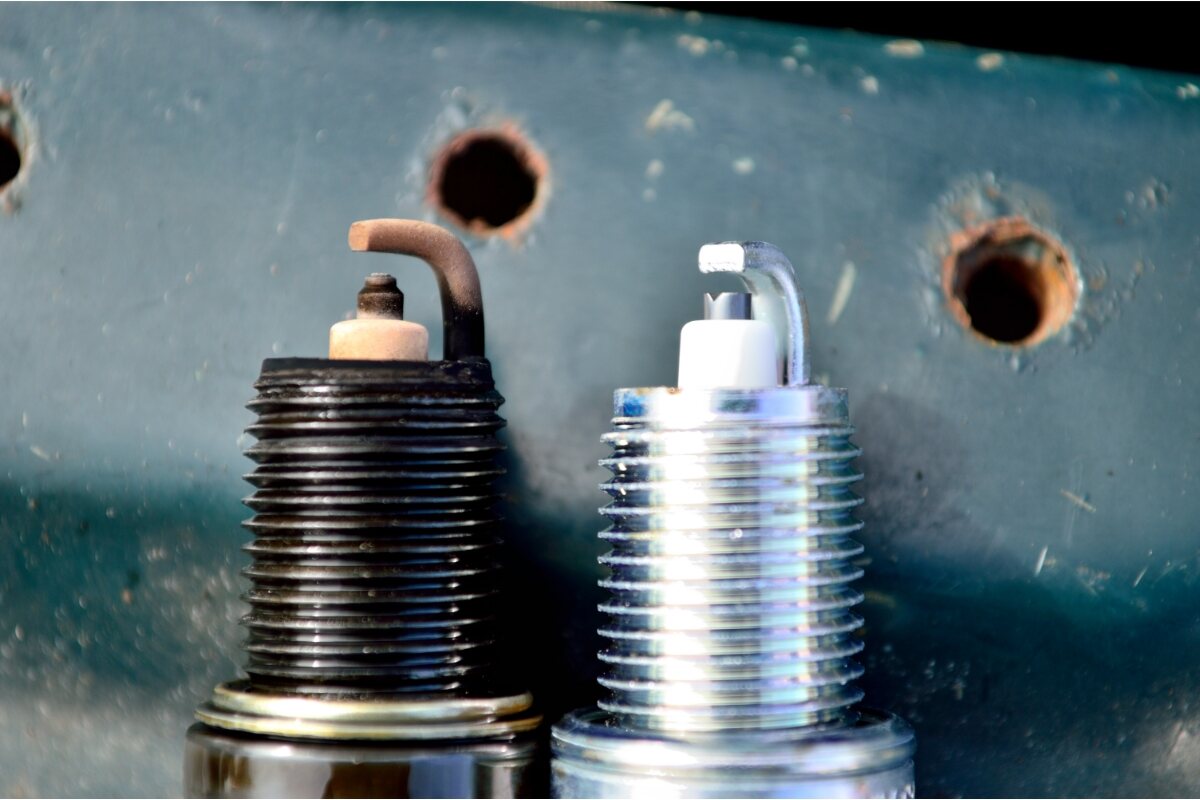
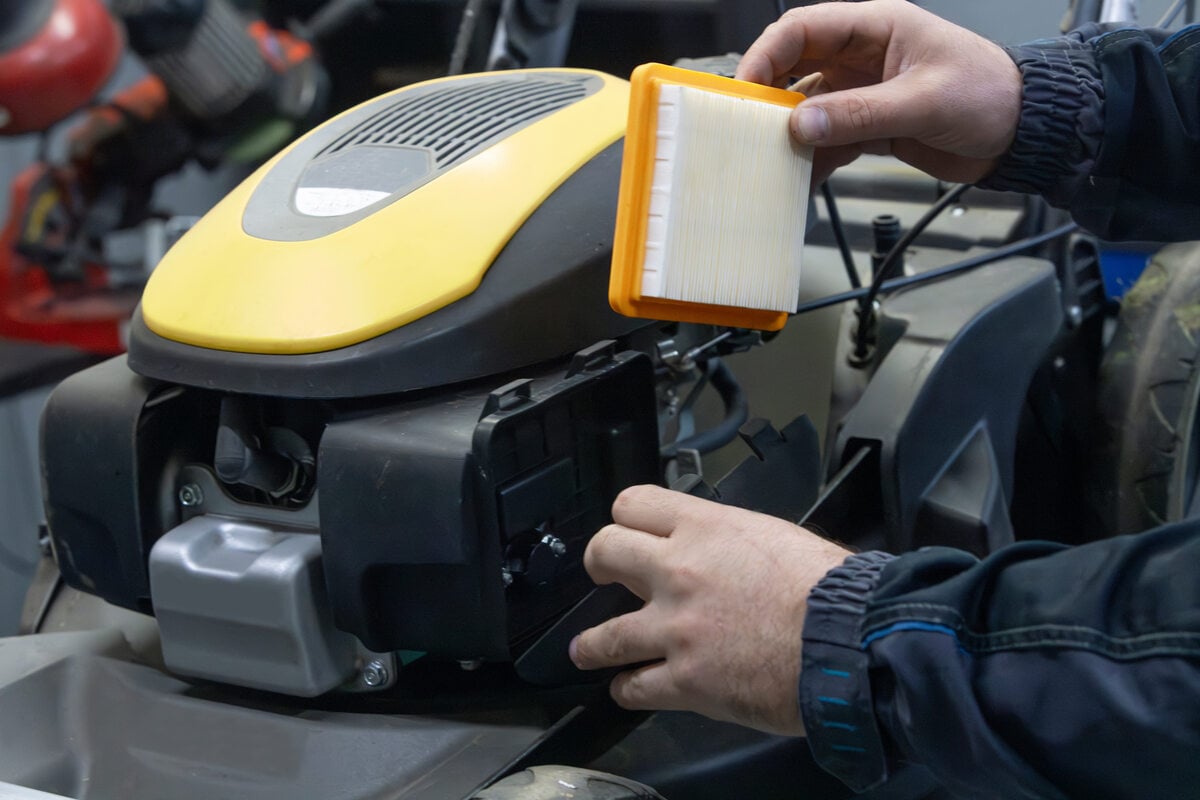

![7 Best Gas Lawn Mowers of 2025 [Reviews] person usiing lawn mower with text overlay on it](https://www.lawnstarter.com/blog/wp-content/uploads/2021/07/Best-Gas-Lawn-Mowers.jpg)
